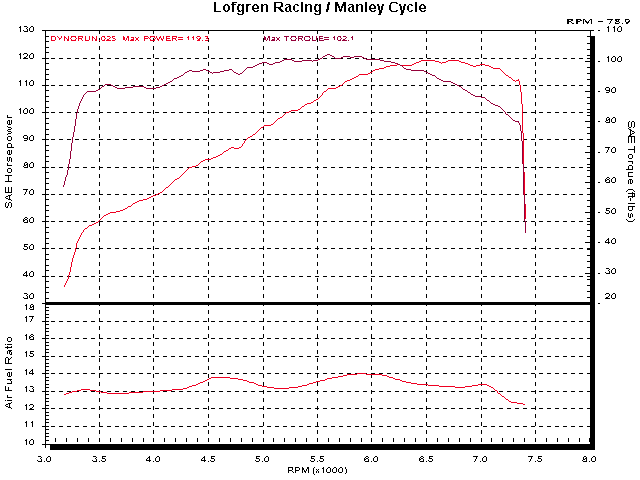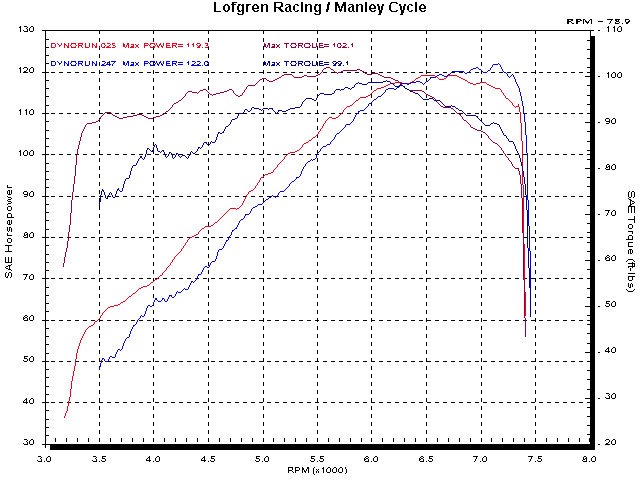
Another Dual Inlet Sportster
Leo Hess from Full Blast Engineering in Sioux Falls, South Dakota had a customer who wanted high performance from his 883 Sportster. He's a long time friend of Mike Roland's, and in touch with him regularly, so he knows about the Buell thing.
Well, Mike had another set of separate inlet heads and a set of 3 13/16" cylinders, so off they went to Leo.
The engine was built on an set of S&S Sportster cases with knife-edged flywheels and S&S rods. The Bore and Stroke are 3 13/16" X 3 13/16", for 87.046 CI.
It uses the same cams as Mike's Buell, 0.625" lift inlet and .500" lift exhaust, and the same valve sizes.
The pipes were made 1 inch shorter than the pipes on Mike's and the inlets used the existing Shumaker manifolds (which are too short) and 2-2" spacers on each side.
The carbs are S&S Super 'E's, much modified.
Mike gave Leo some jetting recommendations for the 'E's, but as these kind of projects happen, the carbs were left stock and some 'break-in' miles were put on it 'as-is'.
The first start-up on the dyno proved to be a bit of a problem. The plugs were sooty and one of them refused to jump the gap. A plug change was in order.
The stock S&S carb calibration is far off with this combination (they are excellent with 'Y' manifold engines.) This can be seen in the following dyno sheet.

The Dynojet WINPEP software allows you to display graphs with up to 4 axis. The one above has Power in the upper left, Torque in the upper right, Air/fuel ratio in the lower left and none in the lower right. With RPM as the 'X' axis.
A good fuel/air ratio should be around 12.8:1. Any carburated engine will normally produce a fuel/air graph with some ups and downs (a fuel injected engine can be adjusted to be nearly flat.) These are caused by the tuning effects of the pipe and inlets.
You can see that it pegs the sensor on the rich side at 3800 RPM and stays there 'til 5300 RPM. It remains rich all the way up. What you can't see is the lean mis-fire around 3000 RPM as the off-idle goes lean. This was quite variable, but I could feel it through the chassis.
The predominant rich condition would explain why the plugs were sooty!
The initial testing could have been more encouraging, but that is the reality of calibrating the carbs and finding the ignition timing of such an un-familiar engine.
Major carb modification ensued. Mike had already re-shaped the venturis and trimmed the throttle shafts.
We added 'Woop-jets' which are power-jets (one manufacturer sells them as 'Thunder-Jets') that Roland (his nickname has been 'Woop' since I've known him) has used for many years. They are located right at the venturi, and we configured them to have replaceable air-bleeds as well as fuel jets.
We extended the influence of the intermediate circuit by adding another hole to the string of off-idle transition holes.
And, we changed the fixed main air-bleed to a replaceable one.

The lean off-idle condition moved up the range a little, and Mike pointed to the transition at 5750 RPM (the vertical line on the chart) as the cross-over point between the main circuit (to the left) and the 'Woop'-jet' circuit (to the right.)
I didn't feel quite so confident, and commented that I wish I was as sure as he was. Damned if he wasn't 100% correct, and all of the subsequent changes had their effect in the appropriate areas.
We had to solder up one of the upper emulsion holes on the main nozzle, as well as change the fuel jets and air-bleeds around but the final result was quite good.
As sensitive as this engine combination is for carb calibration, it is insensitive to ignition timing. This is a sign of good combustion efficiency. Our timing tests didn't gain much torque so we just settled on the third iteration of ignition map.
We used a programmable ignition system along with the stock vacuum operated retard system (VOS?) This allows us to use more advance at part load for better throttle response and part throttle power, while still having the relatively retarded WOT timing that the engine likes. It also allows us to increase the timing lead at higher RPMs (above the torque peak) to gain a little power after the curve begins to drop.
The final fuel-air ratio curve was quite good. We left it a bit lean because the engine seemed to like it that way, it looked like this;

I think we should look at this engine compared to Mike's Buell engine.
This one is 87CI, Mike's is 73.36CI, a difference of 18.65%. Why isn't the big one 142 HP?
First, if engines are port limited and the ports are exactly the same, the engines should make exactly the same power. Which they almost do. (This 'port limited' thing isn't absolute, but pretty close. If the ports, valves and cams were proportionally larger, I'd expect to see an 18% difference.)
Second, the big one has a little less compression than Mike's.
Third, the big one is tuned for an RPM point a little lower than Mike's. With the same stroke, the peak RPM point could be the same. One phenomenon that I've noticed is that, with the same exhaust dimensions, a larger engine (or a higher compression one) makes the pipe tune at lower RPM points. Being that the pipe is an inch shorter than the one on Mike's, it should tune a little higher, but the extra displacement makes it tune a few hundred RPM lower.
And finally, the inlet isn't quite as long as it should be, so the inlet tuning is a little less than it might be.
Look at a comparison of the two.

This shows the 600RPM difference in tuning points and more torque from the larger engine, in spite of the fact that the inlet tuning may not be what it could.
Including some throttle cable problems, a blown timing cover gasket and all of the carb mods, we accomplished this in about 12 shop hours. Mike's took 247 dyno runs during 5 sessions.
Maybe we're starting to understand this combination?